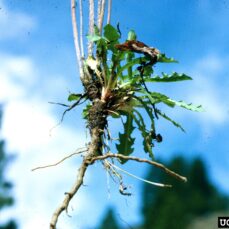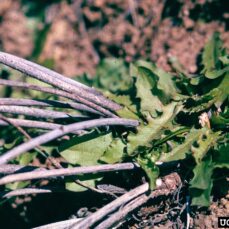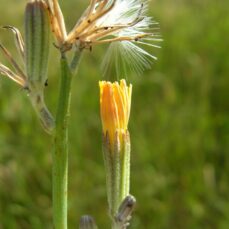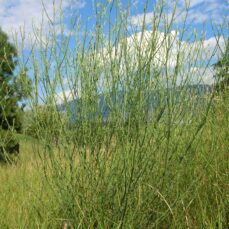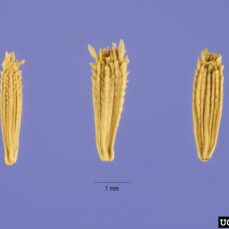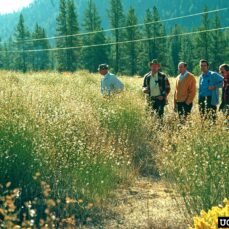
Photo credit: Steve Dewey, Utah State University, Bugwood.org
Management Category
Squamish
Whistler
Pemberton
Vectors of Spread
Synonyms
- Skeletonweed
- Naked weed
- Gum succory
- Devil’s grass
ID Characteristics
Flowers: Each flower head contains 10 – 12 strap-shaped, bright yellow petals. They occur individually or in groups of 2 or 3.
Stems: Mature plants are 0.4 – 1.0 m tall. The base of the stem is coarse with downward-pointing brown hairs. The stem is highly branched with few leaves and contains a milky sap.
Leaves: The leaves are coarsely lobed with fine, dense hair on both sides and sharp spines on the margin. The leaves on the stem are narrower than the ones at the base of the plant.
Roots: Deep, extensive taproot system. Roots are thin and can reach 2 m deep.
Fruits: The seeds are pale brown to nearly black achenes (single seeds) with a white pappus (cluster of hairs).
Similar Species
Native

Photo credit: Alexey Shipunov for Wikipedia
Skeletonplant (Lygodesmia juncea) has pink, occasionally white, flowers and grows in the southern interior of BC.
Habitat and Origin
Rush skeletonweed’s native range spans Western Europe, northern Africa, and central Asia. It was first reported in Washington state in 1938 and is suspected to have been accidentally introduced as a seed and animal fodder contaminant.
Rush skeletonweed generally prefers well-drained and light-textured soils. It thrives in areas with mild winters and warm summers. Rush skeletonweed generally struggles to compete with established native plant communities, so it’s usually found in disturbed areas such as fallow or abandoned fields and roadsides.
How it Spreads
Rush skeletonweed spreads both through seeds and vegetative methods. A single plant can produce as many as 20,000 seeds. The parachute-like seeds emerge 9-15 days after flower production.
Rush skeletonweed can also form new genetically-identical plants from root fragments.
Rush skeletonweed seeds travel easily by wind and water. This plant can also be spread by animals and humans, as well as in seed mixes. Lastly, the movement of soil contaminated with root fragments can also be a vector of spread, as fragments of rush skeletonweed roots can grow into new plants.
Impacts
Ecological:
- Forms dense monocultures, reducing biodiversity.
Economic:
- Reduces livestock and wildlife forage.
- Stems become wiry in maturity and can damage harvesting machinery.
- Contaminates wheat crops.
Rush skeletonweed is a particular concern on agricultural land as it can reduce crop yield by 80%.
Prevent the Spread
Rush skeletonweed is found in the Sea to Sky region, but with a limited distribution. The goal is to eradicate this species from the region, and to prevent new introductions.
Learn to identify rush skeletonweed: Use the images presented in this profile page.
What to do if you spot it: You can report any rush skeletonweed sighting by visiting our reporting page.
DO:
- Regularly monitor properties for weed infestations.
- Remove plant material from any equipment, vehicles or clothing used in infested areas and wash equipment and vehicles at designated cleaning sites before leaving infested areas.
- Ensure soil and gravel are uncontaminated before transport.
- Minimize soil disturbances(e.g., use grazing plants that prevent soil exposure from overgrazing), and use seed mixes with dense, early colonization (e.g., alfalfa or barley) to re-vegetate exposed soil and resist invasion.
- Ensure invasive plants (particularly flowering heads or root fragments) are bagged or covered to prevent spread during transport to designated disposal sites (e.g., landfill).
DO NOT:
- Plant rush skeletonweed in a garden, no matter how well-contained its enclosure may seem.
- Move soil that has been contaminated by rush skeletonweed
- Unload, park or store equipment or vehicles in infested areas; remove plant material from any equipment, vehicles or clothing used in such areas and wash equipment and vehicles at designated cleaning sites before leaving infested areas.
- Compost rush skeletonweed!
Control
Mechanical
- Regular mowing/tilling can prevent seed formation, but will not eradicate rush skeletonweed.
- Small infestations can be hand-pulled, but the operation will need to be repeated regularly, as any root fragment left behind will re-sprout.
- All plant parts and seeds removed should be bagged and disposed of appropriately to avoid further spread.
Chemical
- Herbicides should be applied after the plant has bolted but before it sets seed.
- Repeated applications of a mixture of glyphosate and dicamba or clopyralid and dicamba have been used to control rush skeletonweed.
- Lastly, picloram has been effective when applied to rosettes, but it is not suitable for wet, coastal soils.
We recommend that any herbicide application is carried out by a person holding a valid BC Pesticide Applicator Certificate. Before selecting and applying herbicides, you must review and follow herbicide labels and application rates; municipal, regional, provincial and federal laws and regulations; species-specific treatment recommendations, and site-specific goals and objectives.
Biological
A root-feeding moth (Bradyrrhoa gilveolella), a gall-forming mite (Eriophyes chondrillae), a leaf and stem rust (Puccinia chondrillina, P. acroptili), and a stem gall wasp (Aulacidea acroptilonica) have shown effective for controlling rush skeletonweed.
Sea to Sky Distribution
Rush Skeletonweed Factsheet
Having trouble viewing the factsheet? Don’t worry, all the information is included on this page. You can also contact us with any questions.
References
- Alberta Invasive Species Council, Rush Skeletonweed
- Canadian Food Inspection Agency, Weed seed: Chondrilla juncea (Rush skeletonweed)
- Fraser Valley Invasive Species Society, Rush Skeletonweed
- Government of BC, “Rush Skeletonweed” in A Guide to Weeds in British Columbia
- Invasive Plant Atlas of United States, Rush Skeletonweed
- Invasive Species Compendium (CABI), Chondrilla juncea Rush Skeletonweed
- Invasive Species Council of BC, Rush Skeletonweed
- Invasive Species Extension, Chondrilla juncea Rush Skeletonweed
- Nez Perce Soil & Water Conservation District, Rush Skeletonweed Identification
- Techline Invasive Plant News, Rush Skeletonweed Management: Challenges and Solutions
- United States Department of Agriculture, Rush Skeletonweed Plant Guide
- United States Department of Agriculture, Managing Rush Skeletonweed






